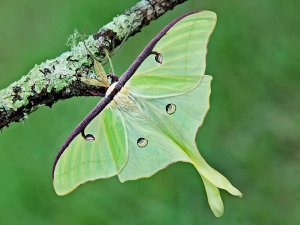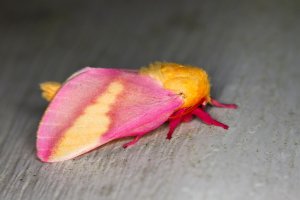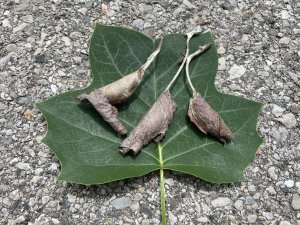Wild Wednesday: Secrets of the Night-Moths
July 27, 2022
When you think about summer evenings in southeastern Michigan, the flicker of fireflies or sound of cicadas may come to mind. But do you ever think about moths?
Moths often get an undeserved reputation as the dull and nocturnal version of daytime’s bright and beautiful butterflies. One of the best-kept secrets of summer nights are Michigan’s many giant silkworm moth species. They include the palm-sized, florescent green luna moth

rust-to-chocolate colored, eye-spotted Promethea, Cecropia, Io, and Polyphemus moths with wingspans in the 4-6 inch range; and even a small hot-pink-and-yellow patterned rosy-maple moth

While moths may not be as well known, there are approximately 8 species of moth to every single species of butterfly on the planet. And after dark, moths of all shapes, sizes, and colors come out of hiding. As part of the nighttime pollination crew, moths have important ecological roles to play. Many feed on nectar, move pollen from plant to plant, and are eaten, in turn, by a variety of nocturnal animals.
Mothing, or the art of searching for moths, is a great way to explore nature in your neighborhood. Moths, like many insects, are attracted to lights. Hanging a light-colored sheet or piece of fabric near a light provides a surface for moths to land on and allows for nighttime observation and identification. Different moths fly at different times and temperatures, with many of the large and showy silkworm moths making late-night appearances well after midnight! If you are curious about moths near you, you can also find a building that has nighttime lighting and investigate the walls and surfaces in the morning. Moths that were attracted to the lights at night may still be resting there in the morning.
While moths and butterflies are dormant during our cold winters, there are still signs of their presence in the winter landscape. Giant silkworm moths are named for the threads that they use to spin their cocoons. The cocoons, often incorporating rolled leaves, protect the caterpillar as it pupates over the winter. Wintertime walks, and careful observation of the host trees of each of the various silkworm species, may lead the sharp-eyed observer to find these well-camouflaged cocoons.

Some, such as the Promethea moth, are retained throughout the winter months on the host trees of tulip tree and cherry. Others, such as the pale leafy cocoon of the luna moth, falls to the ground where it will remain in the leaf litter until spring warms it and the adult hatches out. Fall campaigns to “leave your leaves” help protect species like the luna moth, whose cocoons can be raked up and destroyed by well-intentioned lawn maintainers.
After spending their winter months well-disguised as leaves, the adults hatch out in the warmth of June and July. These adults live only a few short days, where they seek a mate, and then females lay eggs. The adults don’t even have mouthparts, so they don’t eat after the caterpillar stage. Caterpillars typically hatch out in a few days and start the next generation in order to pupate before winter hits.
As you enjoy the long, warm evenings of summer this year, seek out some of these spectacular, secretive silkworm moths.
If you’re interested in learning more about moths, mothing, and National Moth Week check out the resources below:
National Moth Week 2022: https://nationalmothweek.org/
Moths of Ohio is a fantastic, free, online guide to moths: https://ohiodnr.gov/static/documents/wildlife/backyard-wildlife/Moths%20of%20Ohio%20Field%20Guide%20pub5467.pdf
